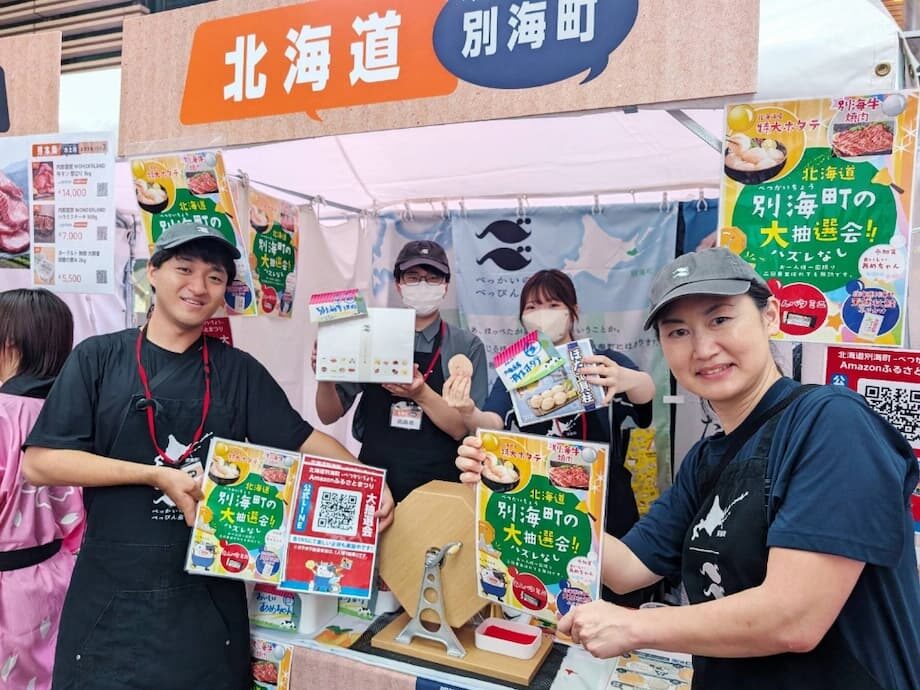Why donations are surging before the point ban
A rush is underway across Japan as people make hometown tax donations before a new restriction cuts off reward points tied to the program. Intermediary websites that link donors and municipalities are rolling out fairs and last minute incentives to capture a final wave of giving ahead of the October rule change. The push comes at a peak moment for the popular system, and it is stirring both record activity and sharp debate over how it should work.
- Why donations are surging before the point ban
- How the hometown tax system works
- What changes in October and what changed already
- How platforms and towns are responding now
- Why reward points drew a crackdown
- What it means for local budgets and strategies
- What donors should keep in mind before the cutoff
- Rakuten’s lawsuit and what to watch after October
- Key Points
Rakuten, one of the largest portals for hometown tax donations, will stage a two day showcase at Tokyo Big Sight where more than 170 municipalities will display gifts and experiences available to donors. Rakuten says donations through its portal doubled in the first 25 days of August compared with a year earlier. Amazon Japan recently held a similar event in Tokyo to channel interest into end of quarter giving. LY, the company behind Line and Yahoo Japan, is running a lottery this month for first time users that offers points equal to 100 percent of the donation amount. Digital marketing firm i Mobile has launched a comparable campaign to convert new donors.
Internal affairs minister Seiichiro Murakami has warned operators not to inflate point giveaways in a final sprint before the rules take effect. Rakuten has filed suit challenging the ban, turning the countdown into a legal and policy showdown over whether points help or hinder the original goal of regional revitalization.
How the hometown tax system works
The hometown tax program, known as furusato nozei, allows taxpayers to redirect part of their residence and income taxes to municipalities of their choice. In return, donors receive local gifts such as specialty foods, crafts, or travel experiences, and their tax bills are reduced the following year. Launched in 2008, the system was designed to support regional development and give city dwellers a way to back hometowns and rural communities facing population decline.
Most people use large portals that list thousands of items from towns nationwide and process payments, shipping, and documentation. The typical out of pocket cost is 2,000 yen per year. The remainder of a person’s donation is returned through tax credits as long as they stay within their annual limit, which depends on income and household circumstances. Gift value is usually set around 30 percent of the donation amount because local rules cap what municipalities can offer to avoid a contest of ever more lavish rewards.
There are two ways to claim the tax benefit. Salaried workers who donate to five or fewer municipalities and are not required to file a tax return can use the one stop exception by requesting it for each donation and submitting the application by January 10. Everyone else files a regular tax return and attaches donation receipts. Foreign residents who pay income and residence taxes in Japan can also participate.
Gifts received through the program count as temporary income for tax purposes, with an annual exemption up to 500,000 yen. Very large donations or additional temporary income can trigger taxes on the gifts. Residence tax for a given year is based on your status as of January 1 of the following year. People who leave Japan before December 31 will not owe residence tax for that year and should not use the program.
What changes in October and what changed already
Starting in October 2025, intermediary portals will be prohibited from awarding reward points tied to hometown tax donations. Regulators have also clamped down on advertising that pushes point back promotions. The government’s stated aim is simple. It wants more of every donation to reach town budgets rather than be recycled into marketing incentives.
This follows an earlier overhaul of cost rules. Since October 2023, local authorities must keep the combined cost of the gift, shipping, administrative processing, and portal fees below 50 percent of each donation. Administrative costs now explicitly include tasks for the one stop exception and the issuance of donation certificates. Fees paid to portals count in full, even when labeled as system management. The longstanding cap that keeps gift value around 30 percent remains in place within that total cost ceiling.
Those changes have forced many municipalities to raise the listed donation amount for popular gifts or reduce what is included. Aomori Prefecture increased prices by about 30 percent in some categories as shipping and raw material costs climbed. Other municipalities are shifting from heavy gourmet items to travel vouchers and tickets to local events to spotlight culture while avoiding logistics costs.
How platforms and towns are responding now
With the point window closing, platforms are pairing online promotions with real world showrooms during the peak donation season. The Rakuten fair at Tokyo Big Sight gives shoppers a chance to taste food, inspect crafts, and speak directly with officials from hundreds of towns in one place. Amazon Japan ran a similar hands on push to prime interest before the rule shift.
Local officials say they expect a drop in traffic once points disappear, so they want to capture attention while they can. A municipal official helping coordinate one of the weekend events said they need to make the most of the remaining weeks to secure funding for town projects.
We need to appeal now as the ban on points is expected to lead to a decrease in donations.
Operators are also rolling out last minute lotteries. LY says it will award points equal to the entire donation amount by lottery to new users of its portal this month. i Mobile is running a similar campaign. The minister has cautioned that the government will watch for any moves that distort donation behavior in the final stretch before the rules change.
Why reward points drew a crackdown
At the heart of the policy shift is how portal commissions interact with points. Municipalities pay fees to intermediary sites for listing and handling orders. When those fees help fund point giveaways, a portion of the money that donors intend for public services can circle back into private marketing. Regulators argue that this undermines the purpose of the program.
The hometown tax has grown rapidly. In fiscal 2022, total donations neared 1 trillion yen and about 9 million people used the system. The scale has brought side effects that the ministry wants to address.
Past controversies included towns offering high end consumer electronics, which escalated competition in ways that had little to do with regional promotion. There were also cases where contractors handling gifts for local governments mislabeled the origin of meat and seafood. Donations continue to cluster around famous branded foods such as premium beef and crab. That concentrates revenue in a limited set of places and pulls funds from municipalities, especially urban wards, that lack well known specialties.
Officials say the goal is to cool excessive competition and encourage portals to lower commissions so communities receive a larger share. In short, the ministry wants the program to prioritize local benefits rather than the marketing arms race of points and perks.
What it means for local budgets and strategies
In the near term, the end of reward points could depress donation volumes for towns that have relied heavily on portal traffic. That matters because many municipalities use furusato nozei funds for childcare subsidies, local roads, disaster preparedness, tourism campaigns, and other everyday services. Budget planners are preparing for a dip in inflows and looking for ways to protect priority projects.
Municipalities are already adjusting to the stricter expense rules and the coming point ban. Some are trimming gift bundles, others are shifting from bulky foods to local experiences that cut shipping costs. Logistics consolidation and new procurement contracts are also on the table. Intermediary sites are tweaking their business models. Satofull has introduced a plan that discounts some commissions when a municipality outsources full program management, an offer pitched as a way to lower costs while keeping visibility on a large portal.
In Yamanashi Prefecture, Fujiyoshida has kept expenses under the 50 percent ceiling, so it expects fewer changes to its catalog even under the new rules. An official there said the broad purpose of regulation is understood, yet frequent changes have made day to day operations complicated.
The purpose of regulation is understood, but the system is too complicated.
The official added that more attention should go to fee structures on intermediary sites so a larger share of donations flows straight to local governments.
What donors should keep in mind before the cutoff
Before the rule change, donors should confirm their annual donation limit using a reliable calculator based on estimated income. Keep an eye on shipping schedules and stock availability, since year end promotions can strain producers. If you want to spread support, consider balancing popular gifts with donations aimed at specific community projects or disaster recovery funds that many towns list on portal pages.
If you qualify for the one stop exception, request it when you donate or submit the application for each donation by January 10. If you do not meet the requirements or you give to six or more municipalities, plan to file a regular tax return and save all receipts. Either way, keep donation records and delivery notices organized in case you need to verify the tax credit later.
Remember that gifts count as temporary income with an annual exemption up to 500,000 yen. Very large donations or other temporary income in the same year can push you over that threshold. Your residence tax for a year is based on your status as of January 1 of the following year. If you will not be a resident on that date, you should not use the program for that year.
Rakuten’s lawsuit and what to watch after October
Rakuten has sued the government over the coming ban on points. The company argues that reward programs help attract donors and drive money to regional economies. The case adds legal uncertainty just as the industry prepares to change practices.
After October, platforms may shift from point back promotions to content and service features that do not rely on rewards tied to donations. That could include better gift discovery tools, stronger editorial curation, and more direct connections between donors and town projects. Municipalities are also likely to invest in their own donation pages and in relationships with smaller portals to reduce fees.
For donors, the experience may feel simpler. With fewer gimmicks, the focus could move back to the substance of a town’s appeal and the clarity of how each contribution supports local services and jobs. The next few months will reveal how quickly platforms and municipalities adapt, and whether donation volumes stabilize at a new level without points.
Key Points
- From October 2025, intermediary sites will be barred from awarding reward points tied to hometown tax donations.
- Donations are surging ahead of the change, with Rakuten reporting a year on year doubling in the first 25 days of August.
- Platforms are hosting fairs and last chance campaigns, including a 100 percent point lottery for first time users on LY’s portal.
- The internal affairs minister has warned operators against last minute point escalation that distorts donations.
- Rakuten has filed suit to challenge the ban, creating a legal fight alongside the policy shift.
- Expense rules tightened in 2023, requiring gifts, shipping, admin, and portal fees to fit under 50 percent of each donation, with gift value generally capped around 30 percent.
- Municipalities have raised prices or reduced gift sizes, and some are switching to travel and event experiences to cut shipping costs.
- Past issues include offers of expensive gadgets, mislabeling of product origin by contractors, and a skew of donations toward famous branded foods.
- Some towns may see a short term drop in funding after points end, prompting new strategies and fee negotiations with portals.
- Donors should check limits, use the one stop exception if eligible, keep receipts, and watch deadlines, especially the January 10 cutoff for one stop submissions.




